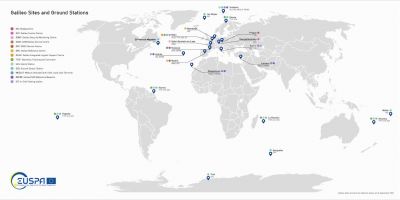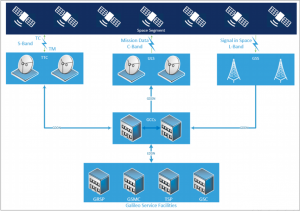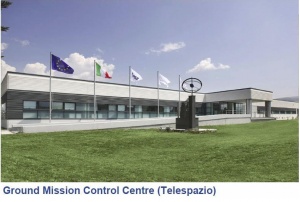If you wish to contribute or participate in the discussions about articles you are invited to contact the Editor
Galileo Ground Segment: Difference between revisions
No edit summary |
Gema.Cueto (talk | contribs) No edit summary |
||
| (10 intermediate revisions by 2 users not shown) | |||
| Line 9: | Line 9: | ||
The [[GALILEO Ground Segment]] comprises two control centres, a global network of transmitting and receiving stations implementing monitoring and control functions and a series of service facilities which support the provision of the Galileo services. | The [[GALILEO Ground Segment]] comprises two control centres, a global network of transmitting and receiving stations implementing monitoring and control functions and a series of service facilities which support the provision of the Galileo services. | ||
The core of the [[GALILEO General Introduction|GALILEO ]] ground segment are the two Galileo Control Centres (GCC). Each control centre manages ''control'' functions supported by a Galileo Control Segment (GCS) and ''mission'' functions, supported by a dedicated Galileo Mission Segment (GMS): The GCS handles spacecraft housekeeping and constellation maintenance while the GMS handles navigation system control.<ref name="Galileo System">[https://www.gsc-europa.eu/galileo | The core of the [[GALILEO General Introduction|GALILEO ]] ground segment are the two Galileo Control Centres (GCC). Each control centre manages ''control'' functions supported by a Galileo Control Segment (GCS) and ''mission'' functions, supported by a dedicated Galileo Mission Segment (GMS): The GCS handles spacecraft housekeeping and constellation maintenance while the GMS handles navigation system control.<ref name="Galileo System">[https://www.gsc-europa.eu/galileo/system Galileo System at European Galileo Service Centre website ]</ref> | ||
The GCS and GMS interfaces the satellites with a worldwide ground station network implementing control and monitoring functions <ref name="Galileo System">[https://www.gsc-europa.eu/galileo | |||
The GCS and GMS interfaces the satellites with a worldwide ground station network implementing control and monitoring functions <ref name="Galileo System">[https://www.gsc-europa.eu/galileo/system Galileo System at European Galileo Service Centre website ]</ref> <ref name="Galileo OS SDD">[https://www.gsc-europa.eu/system/files/galileo_documents/Galileo-OS-SDD.pdf Galileo Open Service - Service Definition Document ]</ref> : | |||
* '''Galileo Sensor Stations (GSS)''', responsible for collecting and sending in real time the data measurements of Galileo SIS. | * '''Galileo Sensor Stations (GSS)''', responsible for collecting and sending in real time the data measurements of Galileo SIS. | ||
* '''Galileo Uplink Stations (ULS)''', responsible for the distribution and uplink of the mission data to the Galileo constellation. | * '''Galileo Uplink Stations (ULS)''', responsible for the distribution and uplink of the mission data to the Galileo constellation. | ||
* '''Telemetry, Tracking & Control stations (TT&C)''', responsible for collecting and sending the telemetry data that was generated by the Galileo satellites and also for the distribution and the uplink of the control commands that are necessary to maintain the Galileo satellites and constellation. | * '''Telemetry, Tracking & Control stations (TT&C)''', responsible for collecting and sending the telemetry data that was generated by the Galileo satellites and also for the distribution and the uplink of the control commands that are necessary to maintain the Galileo satellites and constellation. | ||
The ground segment also comprises a set of Medium-Earth Orbit Local User Terminals (MEOLUTs) serving Galileo’s Search and Rescue service. | |||
[[File: | [[File:Galileo_Global_Ground_Segment.jpg|left|400px|Galileo Ground Segment|thumb]] | ||
There are several services facilities that | There are several services facilities that complement the core infrastructure <ref name="Galileo System">[https://www.gsc-europa.eu/galileo/system Galileo System at European Galileo Service Centre website ]</ref> <ref name="Galileo OS SDD">[https://www.gsc-europa.eu/system/files/galileo_documents/Galileo-OS-SDD.pdf Galileo Open Service - Service Definition Document ]</ref><ref name="Galileo SAR SDD">[https://www.gsc-europa.eu/sites/default/files/sites/all/files/Galileo-SAR-SDD.pdf Galileo SAR Service Definition Document ]</ref> : | ||
*The '''European GNSS Service Centre (GSC)''': located in Torrejón (Spain), the centre represents the link between the Galileo Initial OS (and in the future HAS) user communities and the Galileo system | *The '''European GNSS Service Centre (GSC)''': located in Torrejón (Spain), the centre represents the link between the Galileo Initial OS (and in the future HAS) user communities and the Galileo system | ||
*The '''Geodetic Reference Service Provider (GRSP)''': responsible | *The '''Geodetic Reference Service Provider (GRSP)''': responsible for the data processing that sustain the Galileo Control Centres in order to realise the Galileo Terrestrial Reference Frame (GTRF) consistently with the International Terrestrial Reference Frame (ITRF) | ||
*The '''Time Service Provider (TSP)''': supports the GCC by realising the Galileo System Time (GST) in order to make it aligned to the Coordinated Universal Time (UTC). | *The '''Time Service Provider (TSP)''': supports the GCC by realising the Galileo System Time (GST) in order to make it aligned to the Coordinated Universal Time (UTC). | ||
*The '''Galileo Security Monitoring Centre (GSMC)''': located in St. Germain-en-Laye (France) and | *The '''Galileo Security Monitoring Centre (GSMC)''': located in St. Germain-en-Laye (France) and Madrid (Spain) these facilities are responsible for system security monitoring | ||
*The '''SAR/Galileo Data Service Provider (SGDSP)''': located in Toulouse (France), this entity is responsible of the SAR/Galileo service operations coordination. | *The '''SAR/Galileo Data Service Provider (SGDSP)''': located in Toulouse (France), this entity is responsible of the SAR/Galileo service operations coordination. There is also a MEOLUT Tracking Coordination Facility (MTCF) locate in the SAR/Galileo Service Centre. | ||
*The '''Galileo Reference Centre (GRC)''': located in Noordwijk (The Netherlands), this facility is in charge of the performance monitoring and assessment of Galileo services. This facility is independent from the Galileo core infrastructure and its operations.[[File:Galileo_Ground_Segment_Architecture.png|right|300px|Galileo Ground Segment Architecture|thumb]] | *The '''Galileo Reference Centre (GRC)''': located in Noordwijk (The Netherlands), this facility is in charge of the performance monitoring and assessment of Galileo services. This facility is independent from the Galileo core infrastructure and its operations.[[File:Galileo_Ground_Segment_Architecture.png|right|300px|Galileo Ground Segment Architecture|thumb]] | ||
| Line 41: | Line 43: | ||
The Galileo Mission Segment (GMS) consists of facilities deployed in the two Galileo Control Centres (GCCs) plus a series of Mission Up-Link Stations (ULS) and Galileo Sensor Stations (GSS) deployed at remote sites located around the world. | The Galileo Mission Segment (GMS) consists of facilities deployed in the two Galileo Control Centres (GCCs) plus a series of Mission Up-Link Stations (ULS) and Galileo Sensor Stations (GSS) deployed at remote sites located around the world. | ||
The GMS is responsible for the determination and uplink of navigation data messages needed to provide the navigation and timing data. For this purpose, it uses a global network of Galileo Sensor Stations (GSS) <ref name="Galileo System">[https://www.gsc-europa.eu/galileo | The GMS is responsible for the determination and uplink of navigation data messages needed to provide the navigation and timing data. For this purpose, it uses a global network of Galileo Sensor Stations (GSS) <ref name="Galileo System">[https://www.gsc-europa.eu/galileo/system Galileo System at European Galileo Service Centre website ]</ref> to monitor the navigation signals of all satellites on a continuous basis, through a comprehensive communications network using commercial satellites as well as cable connections in which each link is duplicated for redundancy. | ||
The GMS communicates with the Galileo satellites through a global network of Mission Up-Link Stations (ULS), installed at five sites, each of which hosts a number of 3-meter antennas. ULSs operate in the 5 GHz Radionavigation Satellite (Earth-to-space) band. | The GMS communicates with the Galileo satellites through a global network of Mission Up-Link Stations (ULS), installed at five sites, each of which hosts a number of 3-meter antennas. ULSs operate in the 5 GHz Radionavigation Satellite (Earth-to-space) band. | ||
Latest revision as of 14:53, 20 October 2022
| GALILEO | |
|---|---|
| Title | Galileo Ground Segment |
| Edited by | GMV |
| Level | Basic |
| Year of Publication | 2011 |
The GALILEO Ground Segment comprises two control centres, a global network of transmitting and receiving stations implementing monitoring and control functions and a series of service facilities which support the provision of the Galileo services.
The core of the GALILEO ground segment are the two Galileo Control Centres (GCC). Each control centre manages control functions supported by a Galileo Control Segment (GCS) and mission functions, supported by a dedicated Galileo Mission Segment (GMS): The GCS handles spacecraft housekeeping and constellation maintenance while the GMS handles navigation system control.[1]
The GCS and GMS interfaces the satellites with a worldwide ground station network implementing control and monitoring functions [1] [2] :
- Galileo Sensor Stations (GSS), responsible for collecting and sending in real time the data measurements of Galileo SIS.
- Galileo Uplink Stations (ULS), responsible for the distribution and uplink of the mission data to the Galileo constellation.
- Telemetry, Tracking & Control stations (TT&C), responsible for collecting and sending the telemetry data that was generated by the Galileo satellites and also for the distribution and the uplink of the control commands that are necessary to maintain the Galileo satellites and constellation.
The ground segment also comprises a set of Medium-Earth Orbit Local User Terminals (MEOLUTs) serving Galileo’s Search and Rescue service.
There are several services facilities that complement the core infrastructure [1] [2][3] :
- The European GNSS Service Centre (GSC): located in Torrejón (Spain), the centre represents the link between the Galileo Initial OS (and in the future HAS) user communities and the Galileo system
- The Geodetic Reference Service Provider (GRSP): responsible for the data processing that sustain the Galileo Control Centres in order to realise the Galileo Terrestrial Reference Frame (GTRF) consistently with the International Terrestrial Reference Frame (ITRF)
- The Time Service Provider (TSP): supports the GCC by realising the Galileo System Time (GST) in order to make it aligned to the Coordinated Universal Time (UTC).
- The Galileo Security Monitoring Centre (GSMC): located in St. Germain-en-Laye (France) and Madrid (Spain) these facilities are responsible for system security monitoring
- The SAR/Galileo Data Service Provider (SGDSP): located in Toulouse (France), this entity is responsible of the SAR/Galileo service operations coordination. There is also a MEOLUT Tracking Coordination Facility (MTCF) locate in the SAR/Galileo Service Centre.
- The Galileo Reference Centre (GRC): located in Noordwijk (The Netherlands), this facility is in charge of the performance monitoring and assessment of Galileo services. This facility is independent from the Galileo core infrastructure and its operations.
Galileo Control Segment (GCS)
The Galileo Control Segment (GCS) is responsible for a large range of functions to support satellite constellation control and management of Galileo satellites. The scope of this functionality includes control and monitoring of the satellites and payload, planning and automation functions that allow safe and correct operations to take place, and the support of payload related operations by means of Telemetry Tracking and Control (TT&C) stations links. The GCS provides the telemetry, telecommand and control function for the whole Galileo satellite constellation. Its functional elements are deployed within the Galileo Control Centres (GCC) and the six globally distributed Telemetry Tracking and Control (TT&C) stations. To manage this, the GCS uses the TT&C stations to communicate with each satellite on a scheme combining regular, scheduled contacts, long-term test campaigns and contingency contacts.
A hybrid Communication Network interconnects the remote stations (ULS, GSS, and TT&C stations) with the GCC by different means of standard and special radio, wired data and voice communication links, assuring the communication between all the sites. The two Ground Control Centres (GCCs) constitute the core of the Ground Segment. There are two redundant elements located at Fucino (Italy) and Oberpfaffenhofen (Germany).
The TTC Stations include 13-meter antennas operating in the 2 GHz Space Operations frequency bands. During normal operations, spread-spectrum modulation, similar to that used for Tracking and Data Relay Satellite System, TDRSS, and ARTEMIS data relay applications, are used, to provide robust, interference free operation. However, when the navigation system of a satellite is not in operation (during launch and early orbit operations or during a contingency) use of the common standard TTC modulation allows non-ESA TTC stations to be used.
Galileo Mission Segment (GMS)
The Galileo Mission Segment (GMS) consists of facilities deployed in the two Galileo Control Centres (GCCs) plus a series of Mission Up-Link Stations (ULS) and Galileo Sensor Stations (GSS) deployed at remote sites located around the world. The GMS is responsible for the determination and uplink of navigation data messages needed to provide the navigation and timing data. For this purpose, it uses a global network of Galileo Sensor Stations (GSS) [1] to monitor the navigation signals of all satellites on a continuous basis, through a comprehensive communications network using commercial satellites as well as cable connections in which each link is duplicated for redundancy.
The GMS communicates with the Galileo satellites through a global network of Mission Up-Link Stations (ULS), installed at five sites, each of which hosts a number of 3-meter antennas. ULSs operate in the 5 GHz Radionavigation Satellite (Earth-to-space) band.
The GMS uses the GSS network in two independent ways. The first is the Orbitography Determination and Time Synchronisation (OD&TS) function, which provides batch processing every ten minutes of all the observations of all satellites over an extended period and calculates the precise orbit and clock offset of each satellite, including a forecast of predicted variations (SISA - Signal-in-Space Accuracy) valid for the next hours. The results of these computations for each satellite are up-loaded into that satellite nominally every 100 minutes using a scheduled contact via a Mission Up-link Station.
The OD&TS operation thus monitors the long-term parameters due to gravitational, thermal, ageing and other degradations.
Control Centres Components
The Galileo Control Centres include components of the two Galileo segments, GCS and GMS.
The main GMS facilities are the following ones:
- OSPF: Orbit determination and Synchronization Processing Facility, in charge of the determination of satellite navigation parameters, i.e., ephemeris computation, satellite clock prediction, and determination of the Signal-in-Space accuracy (SISA).
- MGF: Message Generation Facility, which is the facility needed to multiplex all the messages either generated within the GCC or received by external entities, into a single data stream to be sent to each ULS in order to be uploaded to spacecrafts.
- PTF: Precision Timing Facility, responsible for the generation of a physical realization of Galileo System Time (GST) which is provided to all elements for time synchronization purposes.
- GACF: Ground Assets Control Facility, monitoring and controlling all the elements of the GMS in real time.
- MUCF: Mission Uplink Control Facility, which is responsible for the on-line and off-line mission monitoring and control including the Galileo overall long-, mid- and short-term mission planning and uplink scheduling.
- MSF: Mission Support Facility, used to the off-line support functions including the computation of configuration and calibration data for the real-time elements.
- MTPF: Maintenance and Training Platform, which contains the instances of all elements and support equipment for maintenance and training purposes.
- GMS KMF: GMS Key Management Facility, that supports security aspects and data protection (generation of encryption keys, encryption/decryption process,...).
- SPF: Service Product Facility, which is dedicated to the implementation of the exchange gateway between the GCC and the external world.
The main GCS facilities are:
- SCCF: Spacecraft & Constellation Control Facility, that performs the on-line monitoring and control of the satellites, both for routine and critical operations.
- SCPF: Spacecraft & Constellation Planning Facility, which handles the problem of scheduling regular contact (once per orbit) with all satellites in the constellation to support routine operations and special extended contacts to support critical operations.
- FDF: Flight Dynamics Facility, responsible for non-nominal orbit determination (GMS provides nominal) and manoeuver planning.
- OPF: Operations Preparation Facility, responsible for preparation and configuration control of all operational databases and procedures, including those that are destined for automated execution.
- CMCF: Central Monitoring & Control Facility, that supports the monitoring and control of all GCS ground assets, including the TT&C stations, GCC resident facilities and networks.
- GCS KMF: GCS Key Management Facility, that supports security aspects and data protection (generation of encryption keys, encryption/decryption process...).
- CSIM: Constellation Simulator, which is used for validation of operational process, training and anomalies investigation.
Credits
Edited by GMV, using information from the Galileo - Open Service – Service Definition Document and the European GNSS Service Centre website as indicated through the references.



